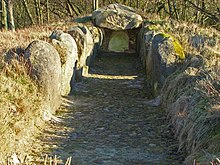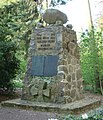Dohnsen (Bergen)
|
Dohnsen
City of Bergen
Coordinates: 52 ° 49 ′ 19 ″ N , 10 ° 1 ′ 25 ″ E
|
|
|---|---|
| Height : | 73 (70-79) m |
| Residents : | 857 |
| Incorporation : | 1st February 1971 |
| Postal code : | 29303 |
| Area code : | 05051 |
Dohnsen is a town in the Lower Saxon town of Bergen in the northern district of Celle in the Lüneburg Heath .
geography
The place is 4 km east of Bergen and has 857 inhabitants (as of 2006). Districts of Dohnsen are Wohlde , Hünenburg , Roxhüllen , Salzmoor and Siddernhausen .
history
The place Dohnsen was first mentioned in a document in 1330 under the name Dodensen .
On February 1, 1971, Dohnsen was incorporated into the city of Bergen.
politics
Dohnsen is represented by the local council and the local mayor. The local council has, among other things, decision-making powers for the public institutions in the locality, is responsible for promoting the maintenance of the local image and club life and must be heard by the city of Bergen on all matters relating to the locality. It consists of five elected representatives, the members of the Bergen municipal council from Dohnsen and the mayor of the city of Bergen.
The local council elects the local mayor , the incumbent is Hinrich Otte.
Culture and sights
- To the north of the village is the stone chamber near Dohnsen, a reconstructed and offset large stone grave from the Neolithic Age (3500–2800 BC).
- About 800 m east of Dohnsen, on the Lührsberg , a 77 m above sea level and about 500 m wide elevation, was discovered in 1936 by Hermannsburg archaeologist Hans Piesker , a settlement of the funnel cup culture (approx. 4200-2800 BC). From the originally 30,000 m² settlement, numerous post holes and settlement pits , but also several house floor plans, were uncovered. The houses were almost 6 m long and were buried between 0.80 m and 1.40 m in the ground. They had wicker walls thrown at them with clay . In addition, arrowheads , scrapers, a spearhead and fragments of hatchets made of flint stones were found and shards of vessels were excavated. The discovery of the spindle whorl made it possible to prove that wool or vegetable fibers were also processed here.
- The other partly preserved barrows in the area (see also barrows near Wohlde and Grabhügelfeld von Bonstorf ) testify that there was settlement here before and during the Bronze Age .
- The Sögel-Wohlde-Kreis is an early Bronze Age (around 1600-1000 BC) cultural group that is named after the places Sögel in the Emsland district and the Wohlde district in Dohnsen.
- The discovery of a bronze cup from Dohnsen could have links to the Mycenaean culture in the 16th to 15th centuries BC. Prove. However, the circumstances of the find are doubtful.
Old farm equipment shed
The village character of the place has been largely preserved. In Dohnsen you can still find original farmhouses, some of which have old oak trees.
Architectural monuments
Economy and Infrastructure
The Dohnsen stop is on the Celle – Soltau railway line . Regular passenger traffic does not take place.
literature
- Ewald Schrader - Chronicle Dohnsen-Wohlde with Siddernhausen, Roxhüllen, Hünenburg u. Salt Marsh Bergen (1976)
- Andrea Hoffmann: HeimatDORF. Local history in the 20th century: Dohnsen, Siddernhausen, Wohlde, Salzmoor, Roxhüllen, Hünenburg , 2008, ISBN 978-3-941092-02-0
Web links
Individual evidence
- ^ Federal Statistical Office (ed.): Historical municipality directory for the Federal Republic of Germany. Name, border and key number changes in municipalities, counties and administrative districts from May 27, 1970 to December 31, 1982 . W. Kohlhammer GmbH, Stuttgart and Mainz 1983, ISBN 3-17-003263-1 , p. 223 .
- ↑ Information on the Lower Saxony municipal constitution
- ↑ s. on the circumstances of the find Hans-Günter Buchholz : Archaeologia Homerica. Chapter E, Part 3, Warfare: Additions and Summary. Verlag Vandenhoeck & Ruprecht, Göttingen 2010, p. 355.





